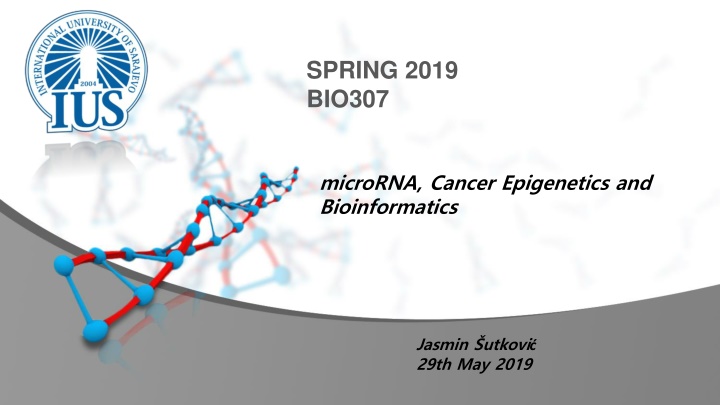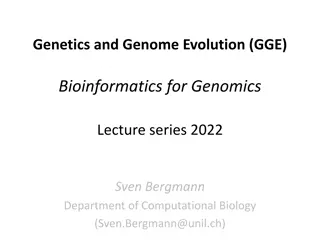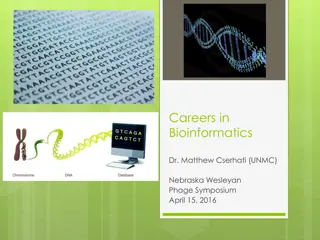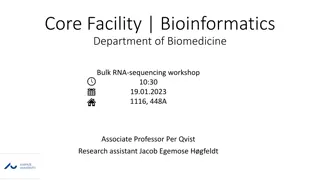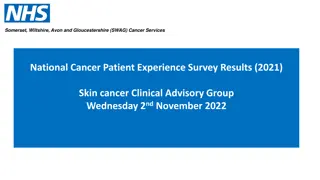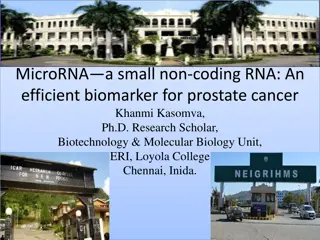MicroRNA and Epigenetics in Cancer Using Bioinformatics
Spring 2019 Bio307 seminar on microRNA, cancer, epigenetics, and bioinformatics. Topics include DNA methylation, microRNA processing, and the role of bioinformatics in analyzing biological data.
Download Presentation

Please find below an Image/Link to download the presentation.
The content on the website is provided AS IS for your information and personal use only. It may not be sold, licensed, or shared on other websites without obtaining consent from the author.If you encounter any issues during the download, it is possible that the publisher has removed the file from their server.
You are allowed to download the files provided on this website for personal or commercial use, subject to the condition that they are used lawfully. All files are the property of their respective owners.
The content on the website is provided AS IS for your information and personal use only. It may not be sold, licensed, or shared on other websites without obtaining consent from the author.
E N D
Presentation Transcript
SPRING 2019 BIO307 microRNA, Cancer Epigenetics and Bioinformatics Jasmin utkovi 29th May 2019
Outline Introduction Micro RNA s Epigenetic DNA Methylation In silico study Bioinformatics Examples
Epigenetic refers to heritable changes in gene expression (active versus inactive genes), that does not involve changes to the underlying DNA sequence; a change in phenotype without a change in genotype. Or Epigenetics refers to covalent modification of DNA, protein, or RNA, resulting in changes to the function and/or regulation of these molecules, without altering their primary DNA sequences.
Micro RNA molecules MicroRNAs (miRNAs) comprise species of short noncoding RNA (18-25 bp) that regulate gene expression post-transcriptionally. Recent studies have demonstrated that epigenetic mechanisms, including DNA methylation and histone modification, not only regulate the expression of protein-encoding genes, but also miRNAs, such as let-7a, miR-9, miR-34a, miR-124, miR- 137, miR-148 and miR-203.
microRNA processing Picture taken from: http://discovermagazine.com/~/media/i mport/images/0/2/6/micrornadiag.jpg
DNA methylation Epigenetic factor that occurs by covalent addition of a methyl group (CH3) on the 5 position of cytosine. Alters the expression of genes in cells as cells divide and differentiate from embryonic stem cells into specific tissues. This event typically occurs in CpG dinucleotide content where 60% to 90 % of all CpGs are methylated in mammals (Varley et al., 2013). Regulation of microRNA expression is influenced by DNA methylation and abnormal methylation is playing an important role in the tumorgenesis (Suzuki et al., 2012).
DNA methylation Picture taken from: https://drjanephilpott.wordpress.c om/tag/dna-methylation/
What is bioinformatics ? It is a discipline that represents a marriage between biotechnology and computer technologies and has evolved the convergence of advances in each of these fields. Today bioinformatics is a field that encompasses all aspects of the application of computer technologies to biological data. Computers are used to organize, link, analyze and visualize co mplex sets of biological data.
In silico study Bioinformatics Using compitutional based methods to analyse biological data Protein structure and function prediction Genome wide screening for epigenetic factors Currently several gene banks are publicly available for micrRNA screening and methylation analysis Correlations can be found between genes, noncoding RNA and methylation Predictictions often match with in vitro studies
Methods The canger genome atlas (TCGA) aimed to analyze the genomic features through sequencing of about 30 different types of cancers TCGA is a joint project (27 instititutes) https://tcga-data.nci.nih.gov/tcga/ - platform for researchers to search, download, and analyze data sets (methylation data, expression of genes, SNPs)
Functional annotation of genes Functional annotation of genes The Database for Annotation, Visualization and Integrated Discovery (DAVID)- v6.7- assigns functions to particular genes ! Famous software- more then 10000 citied papers, some papers were published in many journals of Nature !!! Link :http://david.abcc.ncifcrf.gov/
KEGG KEGG Koyoto Encyclopedia of Genes and Genomes (KEGG) to annotate functions of large scale molecular databases generated by genome sequencing and other high-throughput experimental technologies Used published databases of genes or proteins to generate pathway diagrams Link : http://www.genome.jp/kegg/
Example Cancer related in silico search for genes, microRNA
Experimental Design and Methods 1. Purchase several non-small- cell lung cancer (NSCLC) cell lines Growing them under standard conditions in CO2 incubator 2. Do polymerase chain reaction (qRT-PCR). To investigate Expression of miR-10a and PhoGDI2in cell lines Isolate RNA qRT-PCR assays for detection of miR-10a and PhoGDI2 expression using ready kits To check the PhoGDI2mRNA expression, total RNA will be reverse transcribed by RT-PCR To verify integrity of PhoGDI2expression, GAPDH gene can be used as an internal endogenous control - GAPDH is a housekeeping gene commonly used as a reference for quantification of gene expression. The relative levels of PhoGDI2mRNA can be calculated using the 2- ct method.
3. Effect of DNA methylation To confirm the effect of DNA methylation on miR-10a expression Inhibit methyltion in cells by 5-Aza-CdR - DNA methyltransferase inhibitor, can be detected by qRTPCR ( to check if methylation has reduced the gene expression or not) CpG island methylation can be assessed by bisulfite sequencing- to determine the patterns of methylation . 4. Verification of miR-10a connection to RhoGDI2 expression luciferase reporter vector clononing of the the wild-type 3 untranslated region (UTR) of RhoGDI 2 into the firefly luciferase gene (pLuc) of pCDNA vector. to measure or track expression of the cloned gene. New plasmid will be cotransfected into the cell lines and treated with Lipofectamine 2000 reagent used to increase the transfection efficiency of the plasmid
5. To investigate cell proliferation affects by miR-10a and RhOGDI2 Cell Proliferation Reagent Kit I (MTT) (Roche Applied Science) for cell viability. MiR-10a inhibitors cells and pCDNA/miR-10a will be transfected to our cells and allowed to grow in well plates. Appropriate negative controls will used. Cell proliferation will be documented every 24 h following the manufacturer s protocol Todetermine whether RhoGDI2 could also affect the cell proliferation we will do taget knock down of RhoDGI2expression using RNAi in our cell lines. RNA interference (RNAi) is a means of silencing genes by way of mRNA degradation
Expected Result and Potential Problems Expexted results are in vitro correlation of RhoDGI2 and miR-10a This study will help us to understand the biological roles of the molecules involved in lung cancers suppression and lead us to find potential therapeutic target for the lung cancer. Potential Problems: Besides miR-10a, we may have other microRNA interaction with RhoGDI2,
Oncogenomics (Cancer Genomics) Oncogenomics is a relatively new sub-field of genomics that applies high throughp ut technologies to characterize genes associated with cancer. Cancer is a genetic disease caused by accumulation of mutations to DNA leading to unrestrained cell proliferation and neoplasm formation. The goal of oncogenomics is to identify new oncogenes or tumor suppressor genes that may provide new insights into cancer diagnosis, predicting clinical outcome of cancers, and new targets for cancer therapies. The success of targeted cancer therapies such as Gleevec, Herceptin, and Avastin raised the hope for oncogenomics to elucidate new targets for cancer treatment.
Databases for Cancer Research Cancer Genome Project is an initiative to map out all the somatic intragenic mutations in cancer. COSMIC is a resource Oncomine has compiled data from cancer transcriptome profiles. IntOGen integrates multidimensional human oncogenomic data clas sified by tissue type using the ICD-O terms. International Cancer Genome Consortium is so far the biggest project to collect human cancer genome data. The data is accessible through the ICGC website.
